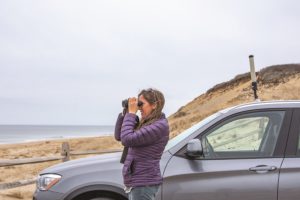PROVINCETOWN — The Center for Coastal Studies (CCS) March 3 sighting of Millipede, a 16-year-old North Atlantic right whale, and her newborn calf — the season’s first — in Cape Cod Bay made headlines across the Cape. Now, the CCS has more good news.
Last Sunday, an aerial surveillance team counted 89 right whales in the bay. Included in that tally were two pairs who joined Millipede and her calf in the mommy-and-me club: 13-year-old Bocce and her calf, and 27-year-old Nauset and her calf.
These 89 whales represent exactly one quarter of the world’s estimated 356 remaining North Atlantic right whales. Each year, they make pit stops in Cape Cod Bay while migrating between calving areas off the coasts of Georgia and Florida and feeding grounds in the Labrador Sea. Last year, more than half the world’s right whale population passed through the bay.

“This sort of thing is special, not only because we have a remarkable density of whales,” said Charles “Stormy” Mayo, director of the CCS Right Whale Ecology Program, “but we also have very active feeding. It’s demonstrably a nursing area … and in addition to that, we’ve had several mating groups. All of that goes on here in our little bay.”
So, seeing those 89 whales in one survey of Cape Cod Bay was not unusual. But the three mother-calf pairs? “That’s pretty special,” said Mayo.
Whale experts agree that, for the critically endangered species to survive, its reproductive rate should hover around 7 percent. But, said Mayo, the rate instead averages between 2 and 4 percent. Only 22 calves have been born in the last four years — and those few calves have struggled to contend with the same Unusual Mortality Event that has killed more than 10 percent of their population since 2017.
Seeing the calves arrive is a bright spot in a species’ dismal situation. But Mayo can’t let himself read too much into good news. “This does not mean anything hugely different for the population’s future,” he said.
For Cape Cod whale watchers, the early boom in right whale calves here offers “a reasonable chance of seeing others.” And, said Mayo, the fact that the bay hosts the highest concentration of North Atlantic right whales on Earth means “people should take advantage of that.”
To the whale-seekers among us, high-tech solutions like going out by boat or private aircraft might seem appealing. But federal law dictates that non-research boats have to stay a minimum of 500 yards from these most endangered of whales, and planes have to stay above 1,500 feet — regulations that don’t make for particularly satisfying sightings. When it comes to Outer Cape whale watching, said Mayo, little can compare to the basics: heading to Race Point or Herring Cove with a pair of binoculars and some hours to spare.
“I’ve had some of the most amazing views of right whales that I’ve ever had, right there on the beach,” he said. “And on flat, calm days — when it’s glassy calm, with hardly any waves — it’s actually possible to hear them breathing.”



